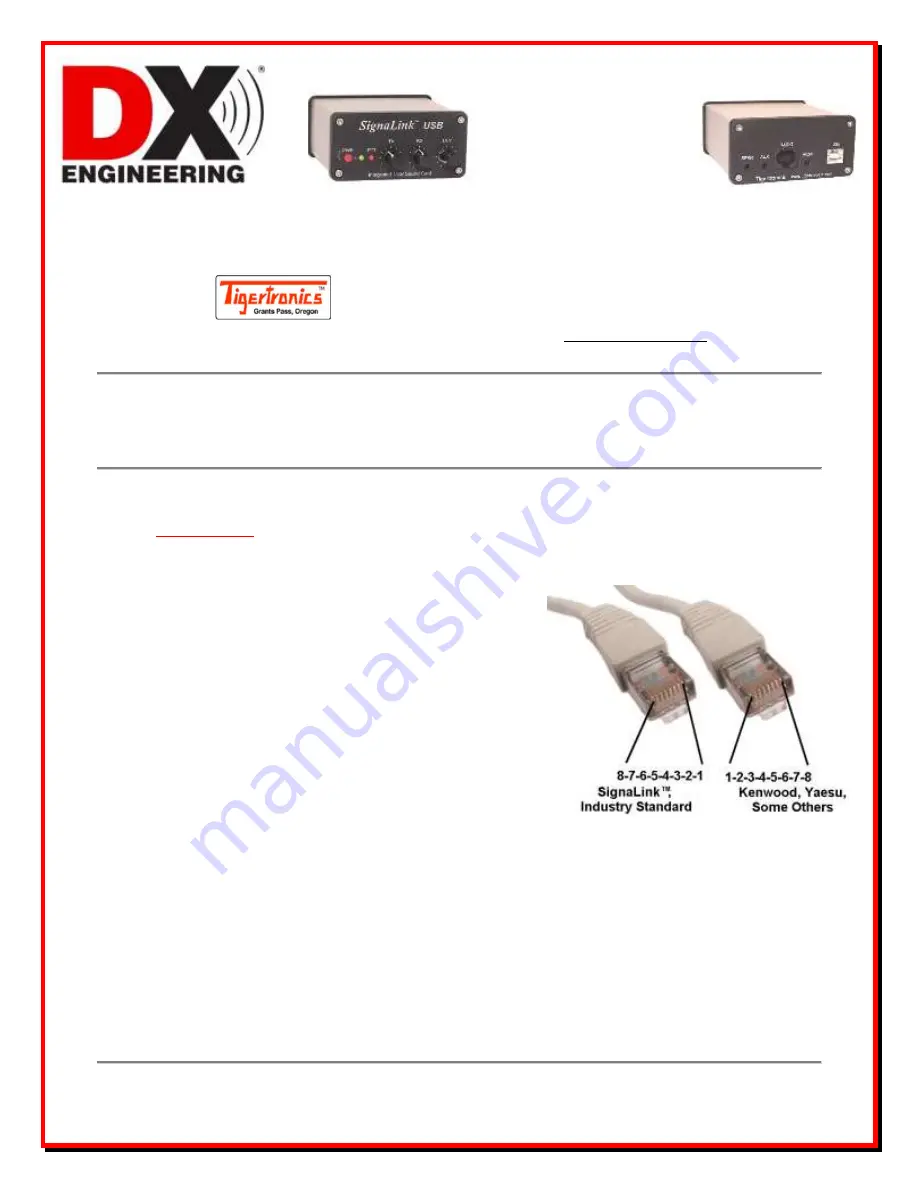
TGR-SL-USB
SignaLink
USB
Cable List - Rev 43
Last Update -1 Feb 2013
Last Tigertronics Update - 9 Jan 2013
Tigertronics
SignaLink
USB Digital Interface - Cable
Interface Listing
SignaLink Jumper Settings & Wiring Information For Base & Mobile Radios
References to other non-USB models have been removed from the original Tigertronics document.
Warning:
Tigertronics has not verified the accuracy of all of the radio wiring information that is provided here. This
information is provided for reference only and is NOT intended to replace the jumper installation procedure in the
“Connecting The Radio” section of the SignaLink Installation Manual. It is essential that you double-check this information
against your radio's manual before doing the actual installation. While it is fairly simple to install the SignaLink, it is
possible to DAMAGE YOUR RADIO or the SignaLink by incorrectly installing it!
IMPORTANT NOTES
SignaLink USB Users -
The SignaLink USB is always powered by the computer's USB jack. When installing the jumpers
for the SignaLink USB using the settings shown here and in our other documentation, please disregard the PWR jumper
(
do
NOT
install it!
). All other jumper settings are the same. Note that if you mistakenly install the PWR jumper, it will
make no difference in the operation of the unit as this pin is not internally connected.
Select The Correct Diagram -
When viewing the jumper settings below,
BE CERTAIN THAT YOU ARE LOOKING
AT THE CORRECT DIAGRAM
for the radio connector that you
will be using. For any given radio, there are likely to be different
jumper settings for the Mic, Data and Accessory Port connectors.
RJ-45 Mic Connectors
-
There is a lack of standardization in the way
that radio manufacturers number their RJ-45 mic connectors. We
have numbered our connector according to the dominant industry
standard as shown to the right. Icom and Radio Shack also follow this
standard, but Kenwood, Yaesu and some others do not. You need to
be very careful to determine how
your
mic connector is numbered to
avoid reversing connections!
PTT
- You should verify in your radio manual that the radio PTT
requirements do not exceed the specifications of the SignaLink keying
circuit (please refer to the SignaLink manual) and that the PTT line is
“Grounded” to make the radio transmit. If your radio exceeds the
specifications listed or requires some other keying arrangement, then
please contact our Technical Support Staff for suggestions.
POWER
-
The SignaLink USB is always powered by the computer's USB jack. When installing the jumpers for the
SignaLink USB, please disregard the PWR jumper. All other jumper settings are the same. If you mistakenly install the
PWR jumper, everything is OK as this pin is NOT connected inside the unit.
Jumper Wire Color
- The jumper wires in the diagrams below are shown in color for illustrative purposes only. The color
of the wires means nothing - they're just easier to see! The actual jumper wires that are included with the SignaLink are all
the same color and can be used to jumper any signal.
Note that the SignaLink USB is always powered by the computer, so you can disregard the PWR jumper when installing
this unit.
RECEIVE AUDIO / SPEAKER AUDIO
- Receive Audio is available on the Mic, Data, and Accessory Port connectors
of most radios. If Receive Audio is not shown in the jumper settings for your radio, then consult your radio manual to see
if it is available. If it is not, then you will need to connect a mono cable between your radio's External Speaker or
headphone jack, and the "Speaker" jack on the back of the SignaLink. See the SignaLink Installation Manual for details.
















